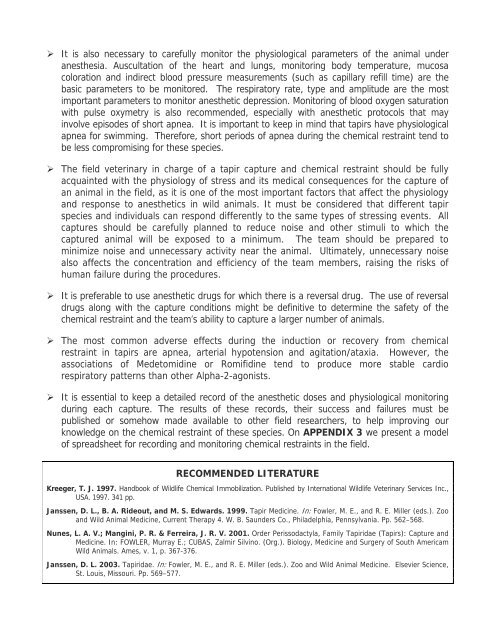TAPIR FIELD VETERINARY MANUAL - Tapir Specialist Group
TAPIR FIELD VETERINARY MANUAL - Tapir Specialist Group
TAPIR FIELD VETERINARY MANUAL - Tapir Specialist Group
Create successful ePaper yourself
Turn your PDF publications into a flip-book with our unique Google optimized e-Paper software.
� It is also necessary to carefully monitor the physiological parameters of the animal under<br />
anesthesia. Auscultation of the heart and lungs, monitoring body temperature, mucosa<br />
coloration and indirect blood pressure measurements (such as capillary refill time) are the<br />
basic parameters to be monitored. The respiratory rate, type and amplitude are the most<br />
important parameters to monitor anesthetic depression. Monitoring of blood oxygen saturation<br />
with pulse oxymetry is also recommended, especially with anesthetic protocols that may<br />
involve episodes of short apnea. It is important to keep in mind that tapirs have physiological<br />
apnea for swimming. Therefore, short periods of apnea during the chemical restraint tend to<br />
be less compromising for these species.<br />
� The field veterinary in charge of a tapir capture and chemical restraint should be fully<br />
acquainted with the physiology of stress and its medical consequences for the capture of<br />
an animal in the field, as it is one of the most important factors that affect the physiology<br />
and response to anesthetics in wild animals. It must be considered that different tapir<br />
species and individuals can respond differently to the same types of stressing events. All<br />
captures should be carefully planned to reduce noise and other stimuli to which the<br />
captured animal will be exposed to a minimum. The team should be prepared to<br />
minimize noise and unnecessary activity near the animal. Ultimately, unnecessary noise<br />
also affects the concentration and efficiency of the team members, raising the risks of<br />
human failure during the procedures.<br />
� It is preferable to use anesthetic drugs for which there is a reversal drug. The use of reversal<br />
drugs along with the capture conditions might be definitive to determine the safety of the<br />
chemical restraint and the team’s ability to capture a larger number of animals.<br />
� The most common adverse effects during the induction or recovery from chemical<br />
restraint in tapirs are apnea, arterial hypotension and agitation/ataxia. However, the<br />
associations of Medetomidine or Romifidine tend to produce more stable cardio<br />
respiratory patterns than other Alpha-2-agonists.<br />
� It is essential to keep a detailed record of the anesthetic doses and physiological monitoring<br />
during each capture. The results of these records, their success and failures must be<br />
published or somehow made available to other field researchers, to help improving our<br />
knowledge on the chemical restraint of these species. On APPENDIX 3 we present a model<br />
of spreadsheet for recording and monitoring chemical restraints in the field.<br />
RECOMMENDED LITERATURE<br />
Kreeger, T. J. 1997. Handbook of Wildlife Chemical Immobilization. Published by International Wildlife Veterinary Services Inc.,<br />
USA. 1997. 341 pp.<br />
Janssen, D. L., B. A. Rideout, and M. S. Edwards. 1999. <strong>Tapir</strong> Medicine. In: Fowler, M. E., and R. E. Miller (eds.). Zoo<br />
and Wild Animal Medicine, Current Therapy 4. W. B. Saunders Co., Philadelphia, Pennsylvania. Pp. 562–568.<br />
Nunes, L. A. V.; Mangini, P. R. & Ferreira, J. R. V. 2001. Order Perissodactyla, Family <strong>Tapir</strong>idae (<strong>Tapir</strong>s): Capture and<br />
Medicine. In: FOWLER, Murray E.; CUBAS, Zalmir Silvino. (Org.). Biology, Medicine and Surgery of South Americam<br />
Wild Animals. Ames, v. 1, p. 367-376.<br />
Janssen, D. L. 2003. <strong>Tapir</strong>idae. In: Fowler, M. E., and R. E. Miller (eds.). Zoo and Wild Animal Medicine. Elsevier Science,<br />
St. Louis, Missouri. Pp. 569–577.










